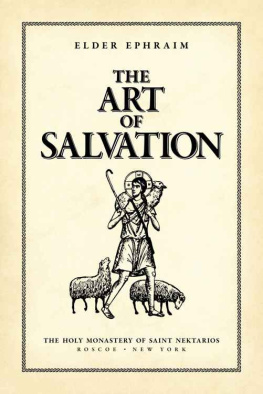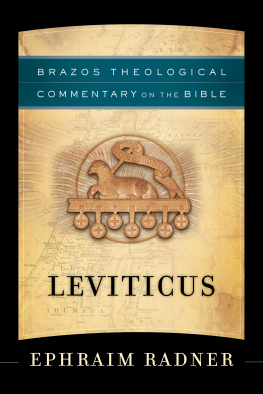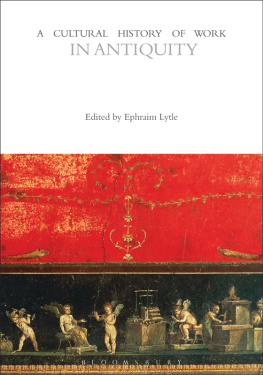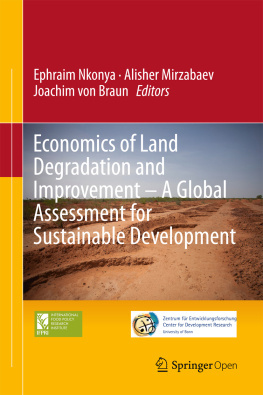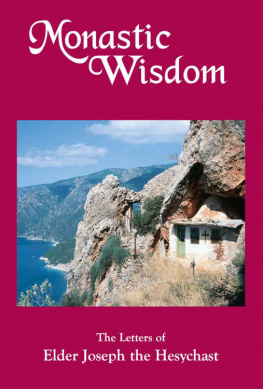Elder Ephraim - The Art of Salvation
Here you can read online Elder Ephraim - The Art of Salvation full text of the book (entire story) in english for free. Download pdf and epub, get meaning, cover and reviews about this ebook. year: 2014, publisher: Saint Nektarios Greek Orthodox Monastery, genre: Religion / Science. Description of the work, (preface) as well as reviews are available. Best literature library LitArk.com created for fans of good reading and offers a wide selection of genres:
Romance novel
Science fiction
Adventure
Detective
Science
History
Home and family
Prose
Art
Politics
Computer
Non-fiction
Religion
Business
Children
Humor
Choose a favorite category and find really read worthwhile books. Enjoy immersion in the world of imagination, feel the emotions of the characters or learn something new for yourself, make an fascinating discovery.
- Book:The Art of Salvation
- Author:
- Publisher:Saint Nektarios Greek Orthodox Monastery
- Genre:
- Year:2014
- Rating:4 / 5
- Favourites:Add to favourites
- Your mark:
- 80
- 1
- 2
- 3
- 4
- 5
The Art of Salvation: summary, description and annotation
We offer to read an annotation, description, summary or preface (depends on what the author of the book "The Art of Salvation" wrote himself). If you haven't found the necessary information about the book — write in the comments, we will try to find it.
The Art of Salvation — read online for free the complete book (whole text) full work
Below is the text of the book, divided by pages. System saving the place of the last page read, allows you to conveniently read the book "The Art of Salvation" online for free, without having to search again every time where you left off. Put a bookmark, and you can go to the page where you finished reading at any time.
Font size:
Interval:
Bookmark:
E l d e r E p h r a i m
the
Art
OF
Salvation

The Holy Monastery of Saint Nektarios
Roscoe New York
Table of Contents
This book has been translated from the Greek original , Holy Monastery of Philotheou
All quotes from the New and Old Testament were taken from The Orthodox Study Bible, St. Athanasius Academy of Orthodox Theology
All quotes from the Psalms were taken from The Psalter According to the Seventy, Holy Transfiguration Monastery
The translator has amended certain biblical quotations to better reflect the original Greek text
All iconography used in this book is taken from the St. Nektarios Monastery chapel of Archangel Michael and the Monastery refectory
This book was printed with the collaboration of Dane Cornel Petersen Dane@PetersenBooks.com

First Printing 2014
Saint Nektarios Monastery Publications
This book has been translated and published by
Saint Nektarios Greek Orthodox Monastery
100 Anawanda Lake Road, Roscoe, NY 12776
www.stnektariosmonastery.org
All rights reserved
Prologue
by His Eminence Hierotheos
Metropolitan of Nafpaktos and St. Vlasios
I consider it a special and exceptional honor to author the prologue of The Art of Salvation , the first volume of homilies by Elder Ephraim (the former Abbot of the Holy Monastery of Philotheou, Mount Athos), as he and the fathers of the Holy Monastery requested. This feeling of honor stems from the fact that Elder Ephraim is a practiced teacher of the watchful way of life of our Orthodox Church.
I first met Elder Ephraim on Mount Athos when he was living at New Skete. I still preserve quite vividly within my heart the image of this fervent ascetic, who is endowed with the ceaseless memory of God and spiritual insight. I am speaking of an ascetic who has lived the spiritual life in practice and who has acquired first-hand knowledge of the passions and how they can be overcome, as well as what constitutes communion with God and how one can attain it. He is a proficient spiritual father with discernment, who ( just like every true monastic hesychast) expresses his distinct ecclesiastical mindset, and simultaneously respects the Bishop whom he asks with extreme humility and his invulnerable grandeur to write the prologue of his first volume of homilies.
Here we witness the association between two gifts that are found within the Church: the life of the monk and the ministry of the Bishop. This further reminds me of the relationship, as well as the humility, that existed between Saint Nicodemos the Hagiorite and Bishop Hierotheos of Evripos, which is evident in their correspondence in the beginning of the book A Handbook of Spiritual Counsel .
The text contained within this book The Art of Salvation are homilies to the monks of the Holy Monastery of Philotheou on Mount Athos, as well as to laypeople, primarily of the United States, who are his spiritual children and whom he guides in the spiritual life.
The characteristic feature of these homilies is their combination of theology with pastoral care. Indeed, when I speak of theology, I am not referring to academic knowledge, which of course is necessary in certain instances in the Churchs historical life, but rather the theology that is a gift, which manifests itself as the experience of God as well as knowledge of the uncreated words and ideas that are perpetually transmitted as a teaching via created words and meanings. Elder Ephraim himself was obedient to a sanctified elder: Elder Joseph the Hesychast. He lived with the noetic prayer, as he was instructed by this ascetical elder and hesychast. He experienced the first grace, in following the second grace (as Elder Joseph very wisely named it), and later he acquired the ability to discern the spirits, which is the true gift of theology.
This theology then becomes a pastoral science that is used to shepherd and guide spiritual children. Such a theologian knows from his own experience the state of Adam prior to his disobedience and fall (for previously he had subsisted in the state of enlightenment of the nous), and the horrible consequences of the fall (since the image of God was obscured, the nous was darkened, and all the powers of the soul were deformed and acquired their unnatural inclinations, resulting in the creation of the passions as we recognize them today). Consequently, such a theologian is familiar with the ascetic, watchful, and hesychastic methodology (i.e., obedience, watchfulness, prayer, and noetic hesychasm), through which man is liberated from the rule of the devil, death, and sin, and develops communion with God in the person of Jesus Christ. As a matter of fact, he even reaches the vision of Gods glory in the human flesh of the Logos, which is Paradise.
Therefore, the close union between theology and pastoral care, between spiritual knowledge and the ministry of shepherding human souls is clearly evident. Only they who have empirical knowledge of Gods mysteries can help others to be liberated from the subjugation of the passions, the devil, and death, something which constitutes the genuine pastoral care of the Church. If someone is lacking these prerequisites, then he will speak gracefully instead of theologically; aesthetically instead of ascetically.
Elder Ephraims homilies take place within these boundaries. Unequivocally, his lecture material is derived from the Holy Scriptures, which are the words of the prophets and Apostles, the immediate witnesses of the bodiless and incarnate Word; from the writings of the holy Fathers of the Church, who are the successors of the Holy Apostles and the bearers of the apocalyptic experience of Pentecost; from The Lives of the Desert Fathers and the Churchs Synaxarion , in which the lives of the true and sanctified members of the Church are visible, who simultaneously are members not of the mystical but of the real Body of Christ; and from narratives taken from and referring to sanctified ascetics of Mount Athos. Above all, however, these spiritual words are shaped by the personal experiences of Elder Ephraim, and this is why they are offered authentically, with simplicity, serenity, and meekness, which are the fruits of Orthodox hesychasm.
I read the homilies contained within this first volume with attention and prayer, most of them within the quietude of the Dormition of the Theotokos Ampelakiotissa Sacred Monastery, which is located within our Holy Metropolis. As I read these writings, I was spiritually edified, and a state of prayer was created within me. Most importantly, I saw who man was before the fall, where he ended up after the fall, and how he can be liberated from the dominion of death. These homilies are indeed alive, informative, inspiring, and lead to repentancethe markers of a genuine Orthodox teaching. These homilies, just as with the spoken words of men who possess the Holy Spirit and have attained communion with Christ through sacred hesychasm, give the impression that the mind of the speaker is moving beyond human boundaries, and they direct the reader to a different understanding of matters that lie beyond the action of the passions and death, in the full sense of the spiritual significance of this word and state.
When I finished reading these homilies, the following verse of Apostle Paul came to mind: Let no man beguile you of your reward in a voluntary humility and worshiping of angels, intruding into those things which he hath not seen, vainly puffed up by his fleshly mind, and not holding the Head, from which all the body by joints and bands having nourishment ministered, and knit together, increaseth with the increase of God (Col. 2:18-19).
Font size:
Interval:
Bookmark:
Similar books «The Art of Salvation»
Look at similar books to The Art of Salvation. We have selected literature similar in name and meaning in the hope of providing readers with more options to find new, interesting, not yet read works.
Discussion, reviews of the book The Art of Salvation and just readers' own opinions. Leave your comments, write what you think about the work, its meaning or the main characters. Specify what exactly you liked and what you didn't like, and why you think so.

